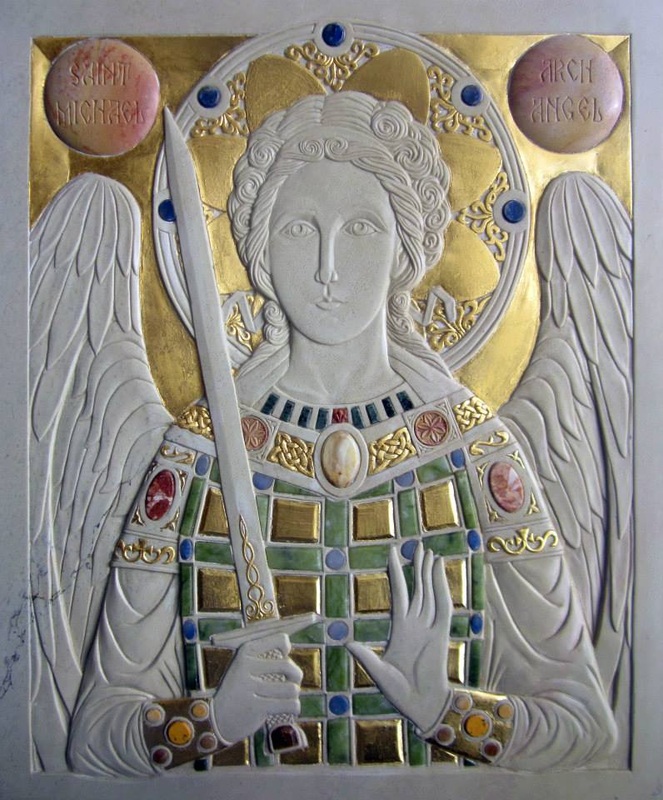
The Danish philosopher, Soren Kierkegaard once said, “Life is not a problem to be solved, but a reality to be experienced”. One might rephrase this, “the truth is not a problem to be solved, but a mystery to be participated in”. This mystery can be translated to us in many forms; through the Divine Services and the Sacraments, through Holy Scripture, and through Holy Icons, which include the sacred architecture of church buildings themselves. The understanding of the importance of symbols and liturgical art has diminished not only in the secular Western consciousness but also, alas, in the consciousness of many Orthodox people living in both East and West.
Two Orthodox Christian artists who have long been trying to address this regression of the Christian phronema, a mode-of-thought that was common to most if not all of the Church Fathers (I think in particular of St. Ephraim the Syrian and his awe-inspiring Hymns on Paradise and St. Gregory of Nyssa and his paradigm shifting work The Life of Moses) are our own beloved Aidan Hart and Jonathan Pageau. Jonathan is a public speaker, a writer, artist and iconographer who creates – among other things – symbolic artwork and beautiful wood-carved icons. He is the Editor of the Orthodox Arts Journal, which focusses on the significance of liturgical art and its revival in the modern world, and he also teaches wood carving classes both in person and online. He is also the owner of The Symbolic World, a website and online community which publishes deeply insightful articles presenting and discussing a wide variety of symbolic motifs in art and literature, both Christian and secular. He has drawn a large number of spiritual and artistic enquirers into the world of Orthodox Christianity and hugely enriched the appreciation and understanding many Orthodox Christians such as myself have of the higher meaning or theoria conveyed through Holy Scripture and Sacred Art.
Recently, Jonathan interviewed Aidan for his popular Symbolic World YouTube channel, and it was truly a privilege and a great blessing to listen to them both discuss the importance of liturgical art to the experience of life with Christ. Though Aidan requires no introduction, even those of us who have known him for many years may get to know him better by learning more about his life and work and the significance of his contribution to the field of liturgical arts.
Jonathan begins the interview by expressing a debt of gratitude to Aidan for the latter’s help and encouragement in the early stages of his career. He then asks Aidan to briefly describe how he came to Orthodoxy and how he came to be a liturgical artist. Aidan speaks of his time studying English Literature and Mathematics as an undergraduate before training to become a teacher. He goes on to tell Jonathan how he was drawn away from this vocation by his desire to pursue his love of art and of sculpture in particular. He describes his desire to bring together the “inner and the outer”, which is to say the spiritual and the material realms, and how he had hitherto begun to develop his own theory of symbolic or sacred art when a friend told him of a recent visit to two Orthodox monks. His curiosity piqued, Aidan decided to visit these monks himself, and it was during this visit that he experienced his first proper encounter with Orthodox icons, whereupon he realised that a sophisticated theory of sacred Christian art already existed and was essentially captured in the Orthodox icon. Moreover, Aidan came to the realisation that what lay behind the icon as an artform was a way of seeing the world and of ‘seeing’ God. Aidan, a Briton raised in New Zealand, had until that time followed the High Anglican tradition, but the encounter with these monks and with the icon effectively led him to become Orthodox and to take up a vocation in the liturgical arts.
Aidan goes on to discuss how he consciously sought to ensure that his art in some way reflected the native Orthodox traditions of the British Isles and could speak to British Orthodox people today, and he goes on to stress that the same principles should be applied to Orthodox art in whatever environment it is created. That is to say, Orthodox art should reflect the common tradition of the Orthodox Church but also the culture of the local church within whom Christ has incarnated and the place in which they are located. Other subjects that Aidan and Jonathan discuss include sacred art and its relationship to secular art; whether or not innovation or novelty is acceptable in liturgical art; the importance of not letting fear prevent us from using our talents; and the essential role beauty plays in attracting people to the Church and facilitating their encounters with God. Saint Nikolai Velimirovich, calls the mystical tradition of the Orthodox Church “nothing else but the science of the highest realities”. He goes on to say that mystical insight provides “a vision of realities beyond and through transparent symbols and signs of the material universe”. Liturgical art can itself be thought of as a kind of symbol or even allegorical language which can, in Aidan’s own words, serve as a door to those higher realities. These two ‘mighty men’ of the liturgical arts, Aidan Hart and Jonathan Pageau, are not only keeping this language and way of thinking alive but helping to revive it in a world that is in danger of going blind as it falls increasingly under the sway of a purely mechanistic mode-of-thought. Both men should be commended for their efforts and have my deepest respect, love and admiration. I encourage you wholeheartedly to listen to their discussion and to enrich your understanding of the liturgical arts and their essential function in the life of the Church.
Luke Thomas